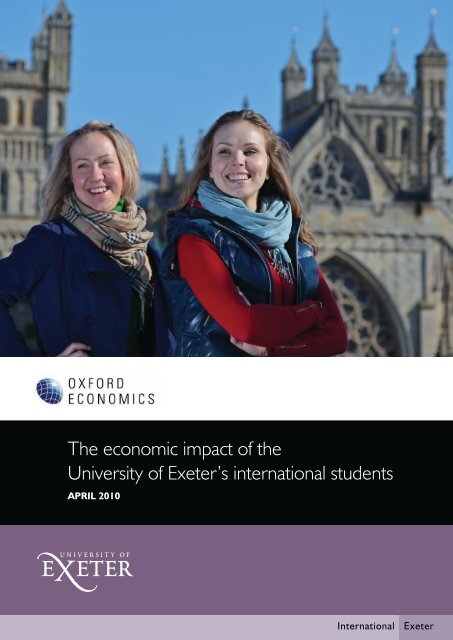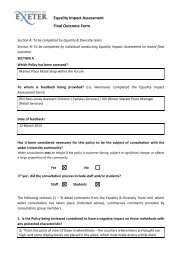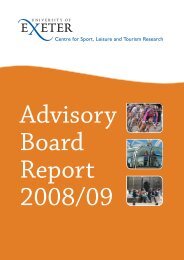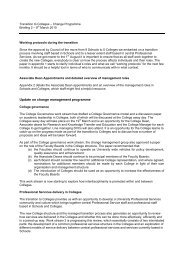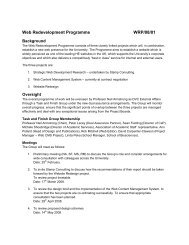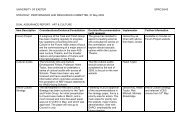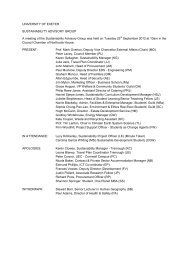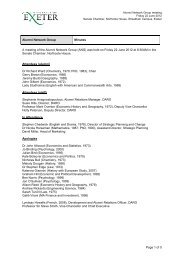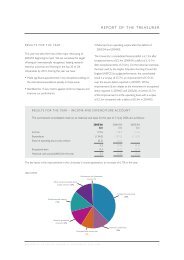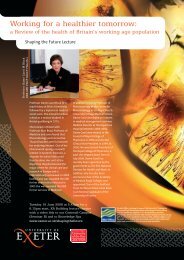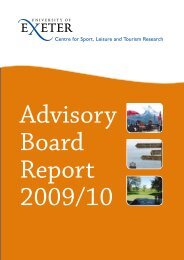Oxford Economics - University of Exeter
Oxford Economics - University of Exeter
Oxford Economics - University of Exeter
Create successful ePaper yourself
Turn your PDF publications into a flip-book with our unique Google optimized e-Paper software.
The economic impact <strong>of</strong> the<br />
<strong>University</strong> <strong>of</strong> <strong>Exeter</strong>’s international students<br />
APRIL 2010
Contents<br />
Executive summary 1<br />
1. Introduction 3<br />
1.1. The brief 3<br />
2. Economic impact <strong>of</strong> the <strong>University</strong><br />
<strong>of</strong> <strong>Exeter</strong>’s international students 4<br />
2.1. Introduction 4<br />
2.2. Fees 4<br />
2.3. Subsistence 8<br />
2.4. Additional visitor impact 10<br />
2.5. Total contribution to gdp 12<br />
2.6. Impact on employment in <strong>Exeter</strong> 13<br />
2.7. Catalytic effects <strong>of</strong> international<br />
students upon <strong>Exeter</strong>’s gdp 14<br />
<strong>Oxford</strong> <strong>Economics</strong> 121, St Aldates, <strong>Oxford</strong>, OX1 1HB<br />
Tel: 01865 268900, Fax: 01865 268906 www.oxfordeconomics.com<br />
The economic impact <strong>of</strong> <strong>Exeter</strong>’s international students
Executive Summary<br />
The <strong>University</strong> <strong>of</strong> <strong>Exeter</strong>’s international students paid<br />
around £30.3 million in fees…<br />
We estimate that the <strong>University</strong> <strong>of</strong> <strong>Exeter</strong> derived about £30.3<br />
million <strong>of</strong> revenues from fees <strong>of</strong> all international students in<br />
2009/10. This added, in total through direct and multiplier<br />
effects, £27.7 million to the city’s economy.<br />
…with subsistence spending by these students<br />
contributing a further £24.4 million to GDP in <strong>Exeter</strong>…<br />
We estimate that the total contribution to <strong>Exeter</strong>’s gdp in<br />
2009/10 from subsistence spending by the 4,000 international<br />
students at the <strong>University</strong> <strong>of</strong> <strong>Exeter</strong> was around £44 million.<br />
Once allowing for imports we find that the impact upon gdp is<br />
around £24.4 million.<br />
…and visits by friends and relatives adding a further<br />
£5.2 million to <strong>Exeter</strong>’s GDP in 2009/10<br />
Our estimates for the total amount <strong>of</strong> spending by visitors to<br />
<strong>Exeter</strong> whose primary reason for entry was to visit a student at<br />
the university is £8 million in 2009/2010. Adjusting for imports<br />
we find that the impact upon gdp is around £5.2 million.<br />
In total, international students studying at the<br />
<strong>University</strong> <strong>of</strong> <strong>Exeter</strong> will contribute £57.4 million to the<br />
city’s GDP in 2009/10 at current prices and support<br />
over 2,100 jobs or 2.3% <strong>of</strong> all jobs in the city...<br />
Note: The figure for international students equates to all non-UK and non-Channel Island students at the<br />
<strong>University</strong> <strong>of</strong> <strong>Exeter</strong>’s two <strong>Exeter</strong> campuses, and is determined by subtracting all UK and Channel Island students<br />
from the total number <strong>of</strong> students at the two <strong>Exeter</strong> campuses.<br />
1<br />
The economic impact <strong>of</strong> <strong>Exeter</strong>’s international students
Executive Summary (cont)<br />
£plus<br />
£5.2<br />
£24.4<br />
GDP<br />
(million)<br />
£27.7 1,050 800 300 plus<br />
cOURsE fEEs<br />
+ sUbsIsTEncE<br />
+ vIsITs<br />
+ cATALyTIc<br />
EmPLOymEnT<br />
…but the catalytic effects mean the overall contribution <strong>of</strong> <strong>Exeter</strong>’s international<br />
students to the economy is far wider than these direct and multiplier effects<br />
These wider benefits are more intangible and so less easy to measure, but nevertheless ultimately<br />
have a very real impact upon the city’s and UK’s economy. These economic benefits result from<br />
the social and cultural links that build up as a result <strong>of</strong> international students studying in the city.<br />
For example, contact that is initially made by visitors studying in <strong>Exeter</strong> may eventually lead to<br />
other economic links as these students become more aware <strong>of</strong> what <strong>Exeter</strong> and the UK more<br />
generally have to <strong>of</strong>fer and return to take up important roles in their home countries.<br />
2<br />
The economic impact <strong>of</strong> <strong>Exeter</strong>’s international students
1. Introduction<br />
1.1. The brief<br />
The <strong>University</strong> <strong>of</strong> <strong>Exeter</strong> has requested <strong>Oxford</strong> <strong>Economics</strong> to undertake an impact study on the<br />
economic contribution <strong>of</strong> international students – i.e., students whose domicile is not in the UK,<br />
from a regional and a local perspective.<br />
The key areas to be included in the quantification <strong>of</strong> this contribution are:<br />
– Fees;<br />
– Subsistence; and<br />
– Family visits while studying at the <strong>University</strong> <strong>of</strong> <strong>Exeter</strong>.<br />
3<br />
The economic impact <strong>of</strong> <strong>Exeter</strong>’s international students
2. Economic impact <strong>of</strong> the<br />
<strong>University</strong> <strong>of</strong> <strong>Exeter</strong>’s international students<br />
2.1. Introduction<br />
This section <strong>of</strong> the report looks at the total economic contribution <strong>of</strong> international students studying at the<br />
<strong>University</strong> <strong>of</strong> <strong>Exeter</strong>’s <strong>Exeter</strong> campuses in 2009/10 under three headings:<br />
• Fees paid;<br />
• Subsistence spending by international students; and<br />
• Visits by family and friends to students while they are studying at the university.<br />
These three drivers can in conjunction be seen as the direct impact <strong>of</strong> international students on the city’s<br />
economy. The report also considers multiplier impacts on other sectors <strong>of</strong> the regional and local economy.<br />
2.2. Fees<br />
In order to derive income from fees we have made use <strong>of</strong> the Financial Statements from the <strong>University</strong> <strong>of</strong><br />
<strong>Exeter</strong>. Here, the income from fees is presented disaggregated by degree type (Undergraduate or postgraduate),<br />
study mode (Full-time or part-time), and fee status (Home / EU or International).<br />
The data does not distinguish between UK and non-UK domiciled for Home / EU students. Therefore, using<br />
the headcount by school, domicile, and campuses we have calculated the number <strong>of</strong> UK domiciled, and<br />
international students out <strong>of</strong> the total number <strong>of</strong> Home / EU students at the <strong>Exeter</strong> campuses, for each degree<br />
type, school, and mode <strong>of</strong> study.<br />
Then, depending on the “Fee Bands” for each school, degree type, and mode <strong>of</strong> study, we have estimated the<br />
amount <strong>of</strong> Home / EU fees that correspond to UK-domiciled and international students. These figures are then<br />
summed and compared to the <strong>University</strong>’s revenue forecasts, and, where different to the forecasts, are used to<br />
pro rata the <strong>University</strong>’s fee income forecasts between UK-domiciled and international students in the Home /<br />
EU fee band.<br />
Table 2-1 presents the fee revenue generated from international students at the <strong>Exeter</strong> campuses in 2009/10,<br />
disaggregated by degree level, and student origin. The table, together with Figure 2-1, shows that for each level<br />
<strong>of</strong> study, the primary source <strong>of</strong> international student fee income is from non-EU students – a result that is not<br />
unsurprising given the differential <strong>of</strong> the fees levied on non-EU and EU students (for example a full-time EU<br />
undergraduate pays £3,225 per year, while a non-EU student doing the same course will pay either £10,000 or<br />
£12,250 depending upon the area <strong>of</strong> study). All-told international students at the <strong>University</strong>’s <strong>Exeter</strong> campuses<br />
spent £30.3 million on fees for the 2009/10 academic year.<br />
4<br />
The economic impact <strong>of</strong> <strong>Exeter</strong>’s international students
Table 2-1: breakdown <strong>of</strong> fee revenue from international students 2009/10 (£ million)<br />
EU Undergraduate 1.7<br />
Non-EU Undergraduate 8.8<br />
EU Taught Postgraduate 1.1<br />
Non-EU Taught Postgraduate 14.0<br />
EU Research Postgraduate 0.7<br />
Non-EU Research Postgraduate 4.0<br />
Total fee Income 30.3<br />
Source: <strong>Oxford</strong> <strong>Economics</strong>/<strong>University</strong> <strong>of</strong> <strong>Exeter</strong><br />
5<br />
The economic impact <strong>of</strong> <strong>Exeter</strong>’s international students
figure 2-1: share <strong>of</strong> fee revenue from international students 2009/10 by origin<br />
100%<br />
80%<br />
60%<br />
40%<br />
20%<br />
0%<br />
Undergraduate Taught<br />
Postgraduate<br />
EU Non-EU<br />
Source: <strong>Oxford</strong> <strong>Economics</strong>/<strong>University</strong> <strong>of</strong> <strong>Exeter</strong><br />
Research<br />
Postgraduate<br />
From this fee income, we have estimated<br />
the direct contribution to local and regional<br />
gdp. This expenditure does not equal direct<br />
gdp, given that some <strong>of</strong> the expenditure <strong>of</strong><br />
the <strong>University</strong> would consist <strong>of</strong> intermediate<br />
consumption, and therefore, would not<br />
contribute to direct local or regional gdp. On<br />
the other hand, some <strong>of</strong> this expenditure will<br />
go, for instance, to pay wages <strong>of</strong> <strong>University</strong><br />
employees that would work in the region,<br />
and therefore would add to both direct local<br />
and regional gdp. We have estimated the<br />
direct gdp impact using the ratio between<br />
expenditure and gdp from our <strong>Exeter</strong> and<br />
South West input-output tables.<br />
Having estimated the direct contribution to gdp, we then estimated the multiplier impact on gdp that is<br />
attributable to fee income using the same input-output tables. The multipliers capture:<br />
• Indirect impacts – employment and activity supported in the local or regional supply chain, as a result <strong>of</strong><br />
purchases <strong>of</strong> goods and services from local suppliers.<br />
• Induced impacts – employment and activity supported by those directly or indirectly employed spending<br />
their incomes on goods and services in the local economy. This helps to support jobs in the industries that<br />
supply these purchases, and includes jobs in retail outlets, companies producing consumer goods and in a<br />
range <strong>of</strong> service industries.<br />
Adding them all up, we will obtain the total contribution to gdp.<br />
Note: Total gdp contribution is composed <strong>of</strong> direct, indirect, and induced gdp.<br />
6<br />
The economic impact <strong>of</strong> <strong>Exeter</strong>’s international students
Table 2-2: contribution to GDP <strong>of</strong> fee revenue from international students 2009/10 (£ million)<br />
<strong>Exeter</strong> South West<br />
Direct effect 21.9 21.9<br />
Indirect effect 0.9 3.0<br />
Induced effect 4.9 7.4<br />
Total fee GDP contribution 27.7 32.3<br />
Source <strong>Oxford</strong> <strong>Economics</strong><br />
Table 2-2 presents the contribution <strong>of</strong> international student fees to both <strong>Exeter</strong>’s and the South West’s gdp.<br />
Utilising the output-to-gdp ratio for education, the £30.3 million expenditure made by international students<br />
on course fees translates to a direct gdp contribution <strong>of</strong> £21.9 million. The direct gdp effect <strong>of</strong> international<br />
student fees is the same for both <strong>Exeter</strong> and the South West, due to the expenditure occurring only within<br />
<strong>Exeter</strong>. differences in the results appear at the indirect and induced effect levels, consequently leading to<br />
different levels <strong>of</strong> total gdp contribution at the local and regional levels.<br />
The payment <strong>of</strong> £30.3 million in fees by international students at the <strong>University</strong> <strong>of</strong> <strong>Exeter</strong>’s <strong>Exeter</strong> campuses<br />
contributes a total <strong>of</strong> £27.7 million in gdp to <strong>Exeter</strong>’s economy. By contrast, the same expenditure<br />
contributes £32.3 million to the South West’s economy. The South West receives a high gdp contribution<br />
from fees than <strong>Exeter</strong> due to the lower level <strong>of</strong> leakage in the economy – for example the purchase <strong>of</strong> goods<br />
by the <strong>University</strong> from a supplier in Somerset creates gdp which is not captured in the <strong>Exeter</strong> economy, but<br />
is captured in the South West economy.<br />
Overall, expenditure on fees by international students in <strong>Exeter</strong> generates a total gdp multiplier <strong>of</strong> 1.27 in the<br />
<strong>Exeter</strong> economy. The gdp multiplier for the South West economy from the same expenditure is higher at<br />
1.47, due to lower levels <strong>of</strong> leakage.<br />
7<br />
The economic impact <strong>of</strong> <strong>Exeter</strong>’s international students
2.3. Subsistence<br />
Subsistence spending refers to all spending by international students on goods and services other than their education<br />
fees. It includes, for instance, expenditure on food, rent, travel and entertainment. For estimating subsistence<br />
expenditure, we have made use <strong>of</strong> the Student Income and Expenditure Survey (SIES). The SIES provides a wealth<br />
<strong>of</strong> information on the spending habits <strong>of</strong> both full- and part-time students, indentifying the key areas in which these<br />
students make purchases. Unfortunately, this survey makes not distinction between domestic and international<br />
students. Therefore, we have adjusted the overall spending figure for students to reflect the different mode <strong>of</strong> study<br />
<strong>of</strong> international students compared to domestic students.<br />
In the 2009/10 academic year some 4,052 international students were based at the <strong>University</strong> <strong>of</strong> <strong>Exeter</strong>’s <strong>Exeter</strong><br />
campuses undertaking full- or part time study; international students represented one-quarter <strong>of</strong> the campuses’<br />
student population. Six percent <strong>of</strong> the international students at the <strong>Exeter</strong> campuses were undertaking part-time<br />
study, with numbers evenly split between EU and non-EU nationals. The remaining 94 percent <strong>of</strong> international<br />
students were engaged in full-time study, with the vast majority coming from the non-EU nations (Figure 2-2).<br />
figure 2-2: International students at the <strong>Exeter</strong> campuses 2009/10<br />
3% 3%<br />
73%<br />
21%<br />
Source <strong>Oxford</strong> <strong>Economics</strong>/<strong>University</strong> <strong>of</strong> <strong>Exeter</strong><br />
Full-time EU<br />
Full-time non-EU<br />
part-time EU<br />
part-time non-EU<br />
From the subsistence expenditure, we will have to<br />
calculate the direct contribution to local and regional<br />
gdp. Expenditure does not equal direct gdp, because<br />
some <strong>of</strong> the goods and services bought by the<br />
students would be sourced from abroad or in other<br />
regions <strong>of</strong> the UK and abroad. However, students will<br />
also spend their money for instance, on local pubs<br />
and restaurants employing local people, therefore<br />
contributing to direct regional gdp. Again, we have<br />
estimated what proportion <strong>of</strong> expenditure directly<br />
contributes to local and regional gdp, using regional<br />
input–output tables.<br />
Having estimated the direct contribution to local and<br />
regional gdp, we again estimate the multiplier impacts<br />
on local and regional gdp, and adding them up, we<br />
obtain the total contribution to local and regional gdp.<br />
8<br />
The economic impact <strong>of</strong> <strong>Exeter</strong>’s international students
Table 2-3: contribution to GDP <strong>of</strong> subsistence spending by international students<br />
2009/10 (£ million)<br />
<strong>Exeter</strong> South West<br />
Total international Subsistence Expenditure 43.6 43.6<br />
Direct Effect 20.4 20.4<br />
Indirect Effect 1.2 4.2<br />
Induced Effect 2.8 4.6<br />
Total subsistence GDP contribution 24.4 29.2<br />
Source <strong>Oxford</strong> <strong>Economics</strong><br />
Table 2-3 presents the figures for expenditure by international students in <strong>Exeter</strong> in 2009/10. It is estimated<br />
that total spending by international students at The <strong>University</strong> <strong>of</strong> <strong>Exeter</strong> is £44 million. However, at least<br />
some <strong>of</strong> that expenditure is likely to be on imports and so will not result in a boost to the local or regional<br />
economies. Accounting for this we estimate that the boost to <strong>Exeter</strong> and South West gdp in 2009/10 from<br />
spending was about £21 million.<br />
When local supply chains and employee expenditure are taken into account the boost to <strong>Exeter</strong>’s gdp<br />
generated by the subsistence expenditure <strong>of</strong> international students at the <strong>University</strong> <strong>of</strong> <strong>Exeter</strong>’s <strong>Exeter</strong> campuses<br />
grows to £25 million. This results in a gdp multiplier for subsistence spending <strong>of</strong> 1.20 in <strong>Exeter</strong>. As seen with<br />
expenditure on fees, the total boost to the South West economy from subsistence spending is greater than that<br />
experienced by <strong>Exeter</strong>, due to lower leakage levels. In total, the subsistence spending <strong>of</strong> international students at<br />
the <strong>Exeter</strong> campuses boosted South West gdp by £30 million; a gdp multiplier <strong>of</strong> 1.43.<br />
9<br />
The economic impact <strong>of</strong> <strong>Exeter</strong>’s international students
2.4. Additional visitor impact<br />
The final element <strong>of</strong> the calculation <strong>of</strong> the impact <strong>of</strong> international students at The <strong>University</strong> <strong>of</strong> <strong>Exeter</strong> is the<br />
expenditure by friends and relatives from abroad visiting international students who were domiciled in <strong>Exeter</strong><br />
during 2009/10. The source used for this data is the International passenger Survey (IpS). This provides<br />
detailed expenditure by various types <strong>of</strong> visitor to the UK as a whole including data on those who describe the<br />
primary reason for their journey as visiting friends and relatives. The data is also partially broken down by the<br />
country <strong>of</strong> origin <strong>of</strong> the visitors. However, there are three areas in which the data is still insufficiently detailed:<br />
• The IPS provides detailed expenditure data by visitor and country <strong>of</strong> origin for the UK as a whole.<br />
However, the breakdown <strong>of</strong> the data by each region <strong>of</strong> the UK, including South West, is less detailed.<br />
Consequently we have had to produce estimates based upon the available data.<br />
• The IPS data merely specifies that visitors are visiting friends and relatives. It does not specify who<br />
their friends and relatives are, or whether or not they are students. We have assumed here that<br />
visitors are all visiting foreign nationals from their own country and that the percentage <strong>of</strong> these visits<br />
that are to students are proportionate to the percentage <strong>of</strong> the population <strong>of</strong> that nationality that is<br />
made up <strong>of</strong> students. For example, by growing the 2001 Census data by regional population growth<br />
to calculate population figures suggests that there were close to 11,000 persons <strong>of</strong> US citizenship<br />
living in the South West in 2009, while the HESA data shows that there were slightly less than<br />
160 US students in <strong>Exeter</strong> at that time. Consequently we have assumed that around 1.4% <strong>of</strong> the<br />
American visitors to the South West in 2009/10 who claimed to be visiting friends or relatives were<br />
visiting students in <strong>Exeter</strong>.<br />
• Finally, the IPS data does not specify where within the South West visitor spending takes place.<br />
Therefore, we have assumed that those visiting students at the <strong>University</strong> <strong>of</strong> <strong>Exeter</strong> conduct all their<br />
spending in <strong>Exeter</strong>.<br />
10<br />
The economic impact <strong>of</strong> <strong>Exeter</strong>’s international students
Table 2-4: spending by visitors to <strong>Exeter</strong> visiting international students<br />
in <strong>Exeter</strong> 2009/10 (£ million)<br />
<strong>Exeter</strong> South West<br />
Total Visitor Expenditure 7.8 7.8<br />
Direct Effect 4.4 4.4<br />
Indirect Effect 0.3 0.9<br />
Induced Effect 0.6 1.0<br />
Total Additional visitor GDP contribution 5.2 6.3<br />
Source <strong>Oxford</strong> <strong>Economics</strong><br />
Table 2-4 shows our estimates for the total amount <strong>of</strong> spending by visitors to <strong>Exeter</strong> whose primary reason<br />
for entry was to visit a student. Total expenditure by all such visitors to <strong>Exeter</strong> in 2009/10 was £8 million.<br />
However, as some <strong>of</strong> this expenditure would have gone on imports the impact upon gdp would be smaller<br />
than this. Adjusting for this we find that the impact upon gdp is £4 million in both the South West and <strong>Exeter</strong>.<br />
Spending by visitors to students in <strong>Exeter</strong> has a gdp multiplier <strong>of</strong> 1.20, leading the additional visitors attracted<br />
by international students at the <strong>Exeter</strong> campuses to boost <strong>Exeter</strong> gdp by £5 million in 2009/10. Once again<br />
the corresponding gdp multiplier for the South West is greater, at 1.44, than that for <strong>Exeter</strong> due to lower<br />
import levels. Consequently, the gdp boost experienced by the South West as a result <strong>of</strong> these additional<br />
visitors equates to £6 million.<br />
11<br />
The economic impact <strong>of</strong> <strong>Exeter</strong>’s international students
2.5. Total contribution to gdp<br />
The overall contribution to gdp is summarised in Table 2-5 and Figure 2-3. The overall impact <strong>of</strong> the<br />
<strong>University</strong> <strong>of</strong> <strong>Exeter</strong>’s international students on <strong>Exeter</strong> gdp at current prices in 2009/10 was £57.4 million.<br />
The largest contribution was from payment <strong>of</strong> fees by students, which is estimated at £27.7 million (or 48<br />
percent <strong>of</strong> total gdp boost); subsistence expenditure by students is estimated to have contributed £24.4<br />
million (43 percent), while the impact <strong>of</strong> spending by visitors was a relatively minor £5.2 million (9 percent). In<br />
the context <strong>of</strong> the <strong>Exeter</strong> economy, the gdp boost generated by international students at the <strong>Exeter</strong> campuses<br />
equates to 1.6% <strong>of</strong> total <strong>Exeter</strong> gdp.<br />
Table 2-5: Overall contribution to GDP by international students 2009/10 (£ million)<br />
<strong>Exeter</strong> South West<br />
fees<br />
Direct Effect 21.9 21.9<br />
Indirect Effect 0.9 3.0<br />
Induced Effect 4.9 7.4<br />
Total 27.7 32.3<br />
subsistence spending<br />
Direct Effect 20.4 20.4<br />
Indirect Effect 1.2 4.2<br />
Induced Effect 2.8 4.6<br />
Total 24.4 29.2<br />
Additional visitors<br />
Direct Effect 4.4 4.4<br />
Indirect Effect 0.3 0.9<br />
Induced Effect 0.6 1.0<br />
Total 5.2 6.3<br />
Overall Total GDP contribution 57.4 67.8<br />
Source <strong>Oxford</strong> <strong>Economics</strong><br />
12<br />
The economic impact <strong>of</strong> <strong>Exeter</strong>’s international students
43%<br />
figure 2-3: Overall contribution to GDP by international students 2009/10<br />
9%<br />
Source <strong>Oxford</strong> <strong>Economics</strong><br />
48%<br />
Fees<br />
2.6. Impact on employment in <strong>Exeter</strong><br />
Subsistence spending<br />
Additional Visitors<br />
Table 2-5 also presents the total gdp<br />
contribution <strong>of</strong> international students at<br />
the <strong>Exeter</strong> campuses on the economy<br />
<strong>of</strong> the South West. The overall gdp<br />
impact in 2009/10 was £68 million<br />
at current prices. As with the results<br />
for <strong>Exeter</strong> the payment <strong>of</strong> fees was<br />
the largest contributor to this boost,<br />
equalling £32 million. Subsistence<br />
spending by students contributed<br />
£30 million, while additional visitors<br />
generated a gdp boost <strong>of</strong> £6 million.<br />
The impact <strong>of</strong> international students on employment can be calculated by dividing the gdp figure by an<br />
estimate for productivity. The productivity figures we have used here are gdp per employee in the South<br />
West. As with the gdp impacts it is possible to calculate the direct, indirect and induced employment impacts<br />
by dividing the direct, indirect and induced gdp impacts by relevant productivities. At each level <strong>of</strong> impact we<br />
use the productivity <strong>of</strong> the industry in which spending is taking place, which we determine using input-output<br />
analysis. For example, to calculate the direct employment generated by fees we have used an estimate <strong>of</strong> gdp<br />
per employee in higher education (which is in the order <strong>of</strong> £26,000 <strong>of</strong> gdp per employee).<br />
Table 2-6 displays the results <strong>of</strong> these calculations, suggesting that the gdp generated directly from<br />
international students at the <strong>Exeter</strong> campuses supported over 1,770 jobs in <strong>Exeter</strong>. Further impacts throughout<br />
the supply chain and from employee spending lead to a total <strong>of</strong> 2,120 jobs supported by international students<br />
in <strong>Exeter</strong>, equating to 2.3 percent <strong>of</strong> <strong>Exeter</strong>’s workforce. In the South West region as a whole, the spending <strong>of</strong><br />
international students in <strong>Exeter</strong> supports 2,410 jobs.<br />
13<br />
The economic impact <strong>of</strong> <strong>Exeter</strong>’s international students
Table 2-6: Overall employment supported by international students 2009/10<br />
<strong>Exeter</strong> South West<br />
Direct Effect 1,770 1,770<br />
Indirect Effect 70 220<br />
Induced Effect 280 420<br />
Total Employment supported 2,120 2,410<br />
Source <strong>Oxford</strong> <strong>Economics</strong><br />
2.7. Catalytic effects <strong>of</strong> international students upon <strong>Exeter</strong>’s gdp<br />
The main focus <strong>of</strong> the report is on the direct and more easily measurable impacts <strong>of</strong> international students<br />
upon <strong>Exeter</strong>’s economy. However, we will conclude by saying something about other effects which will be<br />
longer term are more intangible and so less easy to measure, but will nevertheless ultimately have a very real<br />
impact upon the UK and <strong>Exeter</strong> economies. We have termed these economic benefits, which result from the<br />
social and cultural links that build up as a result <strong>of</strong> international students studying in <strong>Exeter</strong>, catalytic effects.<br />
They include:<br />
• The injection into the workforce <strong>of</strong> additional well educated and dynamic workers. However,<br />
even if these students return home rather than staying to work in <strong>Exeter</strong> the links that they<br />
build up with the city could show up in other ways. Some for instance will end up working for<br />
UK companies later on in their careers and the language and other social skills that they will<br />
have acquired in their time as students will undoubtedly help with that.<br />
• International students who studied in <strong>Exeter</strong> are also likely to develop a predilection for<br />
UK products both in their personal and pr<strong>of</strong>essional lives. Over time this should act as a<br />
considerable boost to UK exports.<br />
• Indeed the benefits <strong>of</strong> these links should not be underestimated. Many <strong>of</strong> these international<br />
students will return home to eventually play important roles in their country. So a predilection<br />
for or even bias in favour <strong>of</strong> anything British will potentially have a considerable impact upon<br />
the UK economy.<br />
14<br />
The economic impact <strong>of</strong> <strong>Exeter</strong>’s international students
Pr<strong>of</strong>essor Neil Armstrong<br />
Deputy Vice-Chancellor<br />
(Internationalisation)<br />
<strong>University</strong> <strong>of</strong> <strong>Exeter</strong><br />
Northcote House<br />
The Queen’s drive<br />
<strong>Exeter</strong><br />
EX4 4QJ<br />
Email: international@exeter.ac.uk<br />
www.exeter.ac.uk/international<br />
Dr Shaun Curtis<br />
director <strong>of</strong> International <strong>Exeter</strong><br />
<strong>University</strong> <strong>of</strong> <strong>Exeter</strong><br />
8th Floor, Laver Building<br />
North park Road<br />
<strong>Exeter</strong><br />
EX4 4QE<br />
photography: We acknowledge with thanks individual students and staff, Tim pestridge and South West RdA<br />
designed by: Communication Services, <strong>University</strong> <strong>of</strong> <strong>Exeter</strong><br />
published April 2010<br />
14<br />
2010INT009


